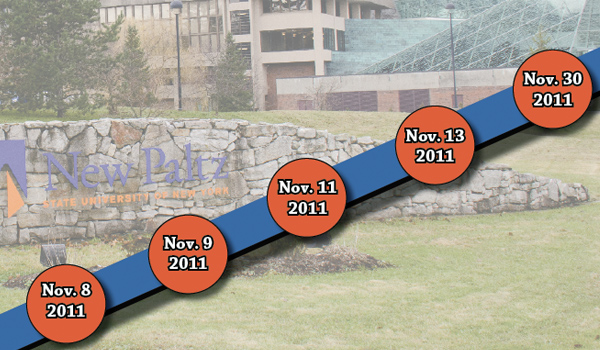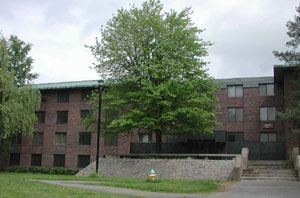
View One Year Later, Campus Remembers ‘Racial’ Postings in a larger map
College and University Police Department (UPD) officials said no one has been charged with posting the “racially offensive” signage on campus last November, as not enough substantial evidence has been collected to charge anyone with the crimes in what President Donald Christian called an “inconclusive” investigation.
UPD Chief David Dugatkin said police investigated “persons of interest” regarding the incidents in the weeks following the postings, which included a sticker hung over a water fountain in the Humanities Building that read “colored only” and posters and graffiti featuring slurs and “racially offensive” content found in LeFevre Hall. However, no one has been arrested in connection with any occurrence.
“There would have to be a missing piece to the puzzle found in order to move forward,” Dugatkin said. “[The case] is open right now, there are no new leads. As issues pop up, we would certainly investigate them, but right now there is no activity on it at this point.”
“Inconclusive” Investigation
On Nov. 8, 2011, the first of what were described as “racial” signs were posted when members of the Student Association (SA) reported to police and college officials that a sticker reading “colored only” had been placed above a water fountain in Humanities Building. The sticker’s placement came one day after the campus celebrated Black Solidarity Day.
Two days later, police were notified of what reports called a “racially offensive poster” in LeFevre Hall. Similar “graffiti” was reported to be found in elevators in the same hall on Nov. 11 and Nov. 13.
In the midst of the postings, Terrell Coakley, former SA president, said students in LeFevre Hall told him that the signs left them afraid to live in their residences because of the offensive slurs.
The events sparked a campus-wide reaction and garnered responses from administration, students and faculty — including a letter addressed to President Christian from the Department of Black Studies.
Immediately after the signs were posted, Christian said the college was committed to “get to the bottom” of the crimes. Dugatkin said those responsible could face harassment charges under penal law, — which could equate to a year of jail time, — and expulsion from the school if they attended SUNY New Paltz.
On Nov. 9, 2011, Christian sent an all-student email that said the posting of the “colored only” sign would not be tolerated on the campus and college officials are “interested both in determining the responsibility and using this incident as a teachable moment for the campus community.”
However, more than a year of searching has yet to lead to an arrest.
During an interview on Oct. 29 of this year, President Christian described the current investigation as one without any closure.
“It’s inconclusive, that’s all that can be said,” Christian said.
Dugatkin said UPD has worked to uncover those responsible for posting the signs, however during interviews and investigation they were unable to find enough evidence to convict someone of the crime and the intent of those responsible was not found.
“Everyone has their own theories, thoughts and beliefs but we have to be able to be certain,” Dugatkin said. “We can’t say what exactly was intended…We have our persons of interest, but nothing more than that, nothing enough to charge criminally.”
In the days following the signs’ posting, UPD investigated a Tumblr post made by a SUNY Oswego student who posted a photo of the “colored only” sticker with a statement that said his friend was trying to start a “race war” at SUNY New Paltz.
As of Nov. 17 of last year, the Oswego student was questioned by UPD. But Dugatkin said after interviewing the student, nothing substantial materialized.
“That person was interviewed and the knowledge and involvement of that person has been documented,” Dugatkin said. “We do not believe that student was responsible for putting [the signs] up, but that person was interviewed.”
Any other “persons of interest” in the case have not been made public.
Freedom of Information Law requests by The New Paltz Oracle to obtain incident reports and investigation reports of the crimes were denied by college officials as the “release of these documents would interfere with an ongoing law enforcement investigation.”
Dugatkin said interviews and investigations took place within “days,” “several weeks” and a “couple months,” after the postings.
Attempts to find out the last time interviews related to the incident were conducted by UPD were also denied by both UPD and college officials.
A Campus Reacts
Students across SUNY New Paltz believe no culprit will be found, but they said the impact of the incidents is still felt on campus.
SA President Josh Simpson said he has not been notified by college officials of any progress in the investigation since he took office earlier this semester, but will now pursue information himself.
“[Students] get into such a fuss over certain things, and then they forget,” Simpson said. “It’s not in the forefront of people’s minds as it was when it happened.”
Simpson said he hopes to address this by hosting more fora similar to the “Can We Talk About It?” program held last year through the use of a $10,000 diversity grant and help from Executive Director of Compliance and Campus Climate Tanhena Pacheco-Dunn.
 “I want it to be remembered,” Simpson said. “It’s a reminder that this isn’t a post-racial society. People still foster racial mindsets that until people are further educated and behavior changes, we will have incidents like this not only on campus, but all over the country.”
“I want it to be remembered,” Simpson said. “It’s a reminder that this isn’t a post-racial society. People still foster racial mindsets that until people are further educated and behavior changes, we will have incidents like this not only on campus, but all over the country.”
SA Vice President of Academic Affairs and Governance Jonathan Espinosa, who found the “colored only” sign and alerted SA members and college officials, said the discovery of a culprit is not as important to him as remembering the importance of the conversations brought up following the postings.
“Personally it doesn’t matter to me if a person is caught or not,” Espinosa said. “It’s not going to solve the issue of racism. I think it’s more important to remember our response to it and how we are not going to let it happen again.”
Espinosa said the incidents in November were a springboard for institution-wide changes — including Coakley’s campaigning for the $10,000 diversity grant and the creation of the Director of Compliance and Campus Climate position, — and that the event should be looked at as a point of transition.
“I’m glad that person actually did that because it shows how prevalent racism is,” Espinosa said. “I was more concerned with our response to it — how would we as a school respond to this act? How will it bring us closer together? That was my concern, and that was my goal of making something of this: that it would bring the awareness up about it.”
Other students not associated with SA shared similar beliefs a year after the events occurred.
Jada Young, a fourth-year Black Studies major, said she didn’t think anyone would be deemed responsible for the incidents for a variety of reasons, but thinks the campus-wide conversation that was started was important to continue.
“I think the reason no one was found is because people won’t talk,” Young said. “Those who might know who posted the sticker won’t give up their friends…I would be interested in hearing what he or she has to say in response, though. But for all we know, he/she could have already graduated [or] transferred [or] studied abroad and I think we’ll likely never know who it was.”
Young said continuing the conversations is important because, like Simpson and Espinosa, she believes the initial shock of the event has withered away over time.
“I…think that a significant amount of the student body has mentally moved on from the buzz and almost excitement the controversy caused the campus,” Young said. “I think that at this point, the situation is seen as old news throughout campus…I do however think those campus dialogues need to continue because they offer great possibility to the campus community.”
Moving Forward
Though no culprit has been apprehended for the posting of the signs, members of the campus community said they have continued to find ways to use the incident to bring about broader conversations about race on campus and safety concerns.
This October, SA announced that a $10,000 diversity grant Coakley applied for would be used to host a series of fora to address social issues at New Paltz. Besides touching on racial issues on campus, the fora will touch on transgender issues, sexual assault and students with disabilities.
Simpson has said he hopes the fora will be scheduled throughout the spring 2013 semester.
In terms of finding someone responsible for the signage, Dugatkin said the case will be considered “open” indefinitely — or until someone is found responsible.
“Resolution can come by arrest, admission or determination of what the intent was,” Dugatkin said. “That’s part of whether or not we determine if there was criminality involved. It seems, by looking at the wording, that it’s obvious. But doing the right thing comes down to knowing what the true intent was and that only comes by talking to the person involved.”
